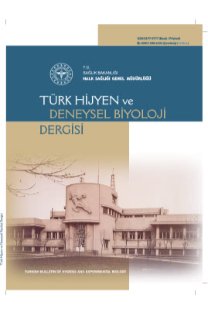Karbapenemlere dirençli non-fermenter Gram negatif basillerde antibiyotik direnci ve metallo-beta-laktamaz pozitifliği
Antibiotic resistance and metallo-beta-lactamase positivity in carbapenem-resistant non-fermentative Gram negative bacilli
___
- 1. Curcio D. Multidrug resistant Gram negative bacterial infections: are you ready for the challenge? Curr Clin Pharmacol, 2014; 9 (1): 27-38.
- 2. Fast W, Sutton LD. Metallo-?-lactamase: inhibitors and reporter substrates. Biochim Biophys Acta, 2013; 1834 (8): 1648-59.
- 3. Ranjan S, Banashankari G, Babu PS. Comparison of epidemiological and antibiotic susceptibility pattern of metallo beta lactamase positive and metallo beta lactamase negative strains of Pseudomonas aeruginosa. J Lab Physicians, 2014; 6(2): 109-13.
- 4. McGowan JE Jr. Resistance in non fermenting Gram negative bacteria: multidrug resistance to the maximum. Am J Infect Control, 2006; 34 (5 Suppl 1): S29-37; discussion S64-73.
- 5. Bulut Y, Çağlar H. Gram negatif non-fermantatif bakterilerde metallo beta laktamaz enziminin farklı yöntemlerle gösterilmesi. FÜ Sağ Bil Tıp Derg, 2013; 27 (3): 135-40.
- 6. Farajzadeh Sheikh A, Rostami S, Jolodar A, Tabatabaiefar MA, Khorvash F, Saki A, et al. Detection of metallo beta lactamases among carbapenem resistant Pseudomonas aeruginosa. Jundishapur J Microbiol, 2014; 7 (11): e12289.
- 7. Peter S, Lacher A, Marschal M, Hölzl F, Buhl M, Autenrieth I, et al. Evaluation of phenotypic detection methods for metallo ? lactamases (MBLs) in clinical isolates of Pseudomonas aeruginosa. Eur J Clin Microbiol Infect Dis, 2014; 33 (7): 1133-41.
- 8. Sánchez A, Gattarello S, Rello J. New treatment options for infections caused by multiresistant strains of Pseudomonas aeruginosa and other nonfermenting Gram negative bacilli. Semin Respir Crit Care Med, 2011; 32 (2): 151-8.
- 9. Szejbach A, Mikucka A, Bogiel T, Gospodarek E. Usefulness of phenotypic and genotypic methods for metallo beta lactamases detection in carbapenem resistant Acinetobacter baumannii strains. Med Sci Monit Basic Res, 2013; 19: 32-6.
- 10. Gupta V, Garg R, Garg S, Chander J, Attri AK. Coexistence of extended spectrum betalactamases, AmpC beta lactamases and metallobeta lactamases in Acinetobacter baumannii from burns patients: a report from a tertiary care centre of India. Ann Burns Fire Disasters, 2013; 26 (4): 189-92.
- 11. Bialvaei AZ, Samadi Kafil H. Colistin, mechanisms and prevalence of resistance. Curr Med Res Opin, 2015; 31 (4): 707-21.
- 12. Hsueh PR, Chen WH, Luh KT. Relationships between antimicrobial use and antimicrobial resistance in Gram negative bacteria causing nosocomial infections from 1991-2003 at a university hospital in Taiwan. Int J Antimicrob Agents, 2005; 26 (6): 463-72.
- 13. Lai CC, Wang CY, Chu CC, Tan CK, Lu CL, Lee YC, et al. Correlation between antibiotic consumption and resistance of Gram negative bacteria causing health care associated infections at a university hospital in Taiwan from 2000 to 2009. J Antimicrob Chemother, 2011; 66 (6): 1374-82.
- 14. Yan JJ, Wu JJ, Tsai SH, Chuang CL. Comparison of the double disk, combined disk, and E test methods for detecting metallo beta lactamases in Gram negative bacilli. Diagn Microbiol Infect Dis, 2004; 49 (1): 5-11.
- 15. Kaleem F, Usman J, Hassan A, Khan A. Frequency and susceptibility pattern of metallo beta lactamase producers in a hospital in Pakistan. J Infect Dev Ctries, 2010; 4 (12): 810-3.
- 16. Aksoy MD, Çavuşlu Ş, Tuğrul HM. Investigation of metallo beta lactamases and oxacilinases in carbapenem resistant Acinetobacter baumannii strains isolated from inpatients. Balkan Med J, 2015; 32 (1): 79-83.
- 17. Vasoo S, Barreto JN, Tosh PK. Emerging Issues in Gram negative bacterial resistance: An update for the practicing clinician. Mayo Clin Proc, 2015; 90 (3): 395-403.
- 18. Abdallah M, Olafisoye O, Cortes C, Urban C, Charles C, Landman D, et al. Reduction in the prevalence of carbapenem-resistant Acinetobacter baumannii and Pseudomonas aeruginosa in New York City. Am J Infect Control, 2015; pii: S0196-6553(15) 00114-5.
- ISSN: 0377-9777
- Yayın Aralığı: 4
- Başlangıç: 1938
- Yayıncı: Türkiye Halk Sağlığı Kurumu
Vankomisin dirençli enterokok suşlarının rep-PCR yöntemi ile klonal analizlerinin değerlendirilmesi
Seyit Ahmet BAYIK, İpek MUMCUOĞLU, Neriman AKSU, Şenol KURŞUN
Yeniden önem kazanan arboviral enfeksiyon etkeni: Zika virüs
Aşı epidemiyolojisi: Aşı ve aşılamanın etkileri için epidemiyolojik ölçütler
Murat GÜNAYDIN, İbrahim Çağatay ACUNER, Hava YILMAZ, Nevzat ÜNAL, Adil KARADAĞ, Cafer EROĞLU
Hikmet Eda ALIŞKAN, Emine Duygu BOZKIRLI, Şule ÇOLAKOĞLU, Müge DEMİRBİLEK
Esra Nur TOLA, Emel SESLİ ÇETİN, Ayşe AYNALI, Buket CİCİOĞLU ARIDOĞAN, Süleyman ÖNAL
Polikistik over sendromu ve moleküler yaklaşımlar
Yasemin ÖZTEMUR, Alp AYDOS, Bala GÜR-DEDEOĞLU
Tahir Kemal ŞAHİN, Selma İNFAL
İnsan ve hayvan sağlığı açısından risk oluşturan enterokokal biyofilm yapısının doğası
Nefise AKÇELİK, Maryam DIANI, Mohammad Nima ARIAFAR
Mustafa GÜZEL, Penka MONCHEVA, Petya HRISTOVA, Yasemin GENÇ, Altan AKSOY
